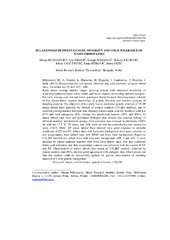Приказ основних података о документу
Relationship between genetic diversity and cold-tolerance of maize inbred lines
| dc.creator | Milivojević, Marija | |
| dc.creator | Nikolić, Ana | |
| dc.creator | Marković, Ksenija | |
| dc.creator | Filipović, Milomir | |
| dc.creator | Vančetović, Jelena | |
| dc.creator | Petrović, Tanja | |
| dc.creator | Srdić, Jelena | |
| dc.date.accessioned | 2019-05-16T12:21:06Z | |
| dc.date.available | 2019-05-16T12:21:06Z | |
| dc.date.issued | 2017 | |
| dc.identifier.issn | 0534-0012 | |
| dc.identifier.uri | http://rik.mrizp.rs/handle/123456789/692 | |
| dc.description.abstract | Early maize sowing enables longer growing season with enhanced possibility of achieving higher and more stable yields, and better chances of avoiding summer droughts. For early sowing, cold-tolerant maize genotypes should be used. Breeding maize, tolerant to low temperatures, requires knowledge of genetic diversity and heterotic patterns of breeding material. The objective of this study was to determine genetic diversity of 15 ZP maize inbred lines applying the method of protein markers (UTLIEF method), and to establish correspondence between thus obtained classification with the results of cold test (CT) and field emergence (FE). During two production seasons (2011 and 2014), 15 maize inbred lines were self-pollinated. Pedigree data showed that material belongs to different maturity and heterotic groups. Cold tolerance was assessed in laboratory (2015) by cold test (7.5 degrees C, 10 days), and field trials on two locations during two successive years (2015, 2016). ZP maize inbred lines showed very good response to stressful conditions of CT and FE. Inbred lines with Lancaster background were more sensitive to low temperatures than inbred lines with BSSS and Iowa Dent background. Based on UTLIEF method two inbred lines with Lancaster background (ZPL 5 and ZPL 7) were grouped by cluster analysis together with Iowa Dent inbred lines, that also expressed better cold tolerance, and thus exceptional consent was achieved with the results of CT and FE. Classification of maize inbred lines based on UTLIEF method, followed by cluster analysis and PCA, showed good agreement with pedigree data, which points out that this method could be successfully applied for genetic classification of breeding material of a wide genetic background. | en |
| dc.publisher | Društvo genetičara Srbije, Beograd | |
| dc.rights | openAccess | |
| dc.rights.uri | https://creativecommons.org/licenses/by-nc-nd/4.0/ | |
| dc.source | Genetika | |
| dc.subject | maize | en |
| dc.subject | cold-tolerance | en |
| dc.subject | genetic diversity | en |
| dc.subject | UTLIEF | en |
| dc.title | Relationship between genetic diversity and cold-tolerance of maize inbred lines | en |
| dc.type | article | |
| dc.rights.license | BY-NC-ND | |
| dc.citation.volume | 49 | |
| dc.citation.issue | 2 | |
| dc.citation.spage | 635 | |
| dc.citation.epage | 646 | |
| dc.citation.other | 49(2): 635-646 | |
| dc.citation.rank | M23 | |
| dc.identifier.wos | 000418533000021 | |
| dc.identifier.doi | 10.2298/GENSR1702635M | |
| dc.identifier.scopus | 2-s2.0-85033590480 | |
| dc.identifier.fulltext | http://rik.mrizp.rs//bitstream/id/2637/690.pdf | |
| dc.type.version | publishedVersion |


